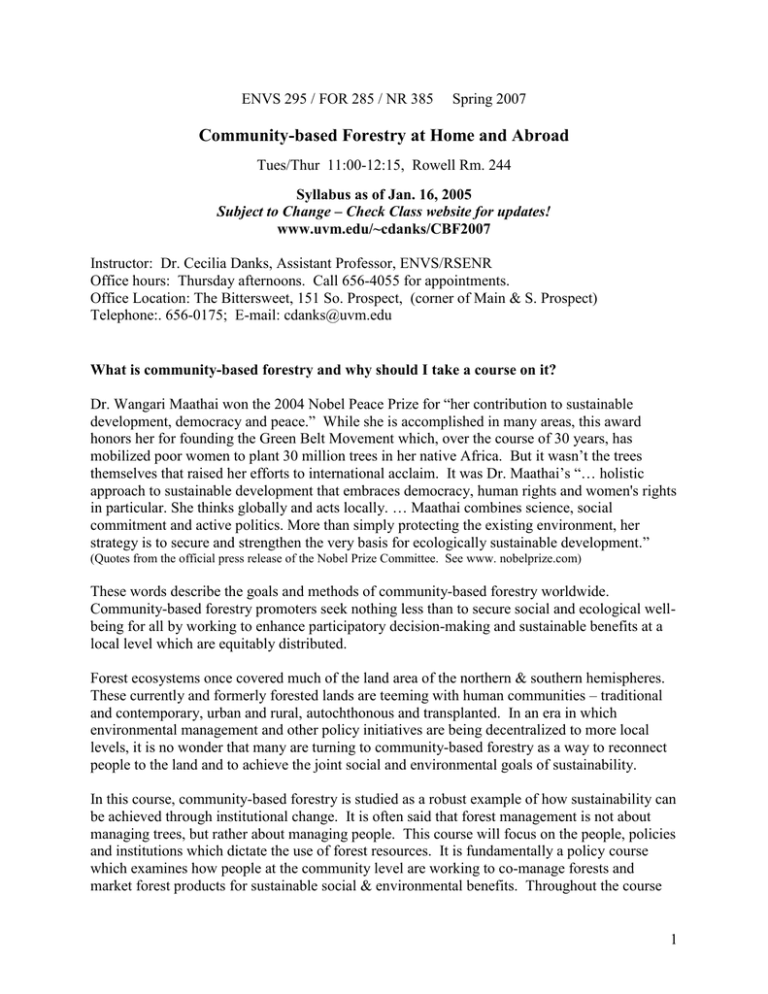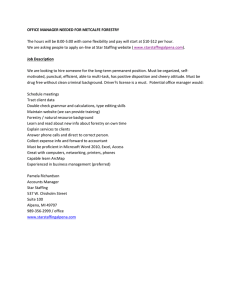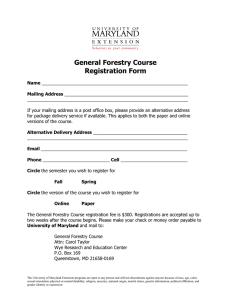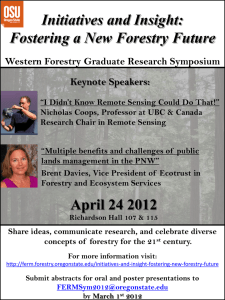Community-based Forestry at Home and Abroad
advertisement

ENVS 295 / FOR 285 / NR 385 Spring 2007 Community-based Forestry at Home and Abroad Tues/Thur 11:00-12:15, Rowell Rm. 244 Syllabus as of Jan. 16, 2005 Subject to Change – Check Class website for updates! www.uvm.edu/~cdanks/CBF2007 Instructor: Dr. Cecilia Danks, Assistant Professor, ENVS/RSENR Office hours: Thursday afternoons. Call 656-4055 for appointments. Office Location: The Bittersweet, 151 So. Prospect, (corner of Main & S. Prospect) Telephone:. 656-0175; E-mail: cdanks@uvm.edu What is community-based forestry and why should I take a course on it? Dr. Wangari Maathai won the 2004 Nobel Peace Prize for “her contribution to sustainable development, democracy and peace.” While she is accomplished in many areas, this award honors her for founding the Green Belt Movement which, over the course of 30 years, has mobilized poor women to plant 30 million trees in her native Africa. But it wasn’t the trees themselves that raised her efforts to international acclaim. It was Dr. Maathai’s “… holistic approach to sustainable development that embraces democracy, human rights and women's rights in particular. She thinks globally and acts locally. … Maathai combines science, social commitment and active politics. More than simply protecting the existing environment, her strategy is to secure and strengthen the very basis for ecologically sustainable development.” (Quotes from the official press release of the Nobel Prize Committee. See www. nobelprize.com) These words describe the goals and methods of community-based forestry worldwide. Community-based forestry promoters seek nothing less than to secure social and ecological wellbeing for all by working to enhance participatory decision-making and sustainable benefits at a local level which are equitably distributed. Forest ecosystems once covered much of the land area of the northern & southern hemispheres. These currently and formerly forested lands are teeming with human communities – traditional and contemporary, urban and rural, autochthonous and transplanted. In an era in which environmental management and other policy initiatives are being decentralized to more local levels, it is no wonder that many are turning to community-based forestry as a way to reconnect people to the land and to achieve the joint social and environmental goals of sustainability. In this course, community-based forestry is studied as a robust example of how sustainability can be achieved through institutional change. It is often said that forest management is not about managing trees, but rather about managing people. This course will focus on the people, policies and institutions which dictate the use of forest resources. It is fundamentally a policy course which examines how people at the community level are working to co-manage forests and market forest products for sustainable social & environmental benefits. Throughout the course 1 we will use community-based forestry as a way to explore three issues: a) how do communities, businesses and government work together to manage common pool resources in ways that promote social and ecological well-being, b) how can good ideas and pilot projects be scaled up to change the dominant social-political-economic systems that affect natural systems, c) what are some of the social justice and diversity issues in resource management and how do communitybased approaches address or exacerbate inequity? We will examine cases from Vermont, the western US, Canada and the developing world. Lessons learned will be broadly applicable for many community-based efforts to promote equity & environmental sustainability. This semester, I have added a service learning component to the course, in which students will work long distance with a community-based forestry organization to enhance their website. This project was chosen as a way to get to know one organization in a different context well and to understand better how one can work “long distance” on a community-based effort. Students will also develop their web saavy – not only the technical skills involved in building a website, but also a more critical understanding of the role of the web in grassroots efforts. Learning Objectives: To gain an understanding of: 1) Practice: a) The common goals and activities of community forestry as an example of sustainable development and sustainable natural resource management b) The diverse forms community forestry takes in different political contexts – in the US & several developing countries 2) Theory: a) Key economic and sociological concepts that underlie community forestry (and many local level sustainable development initiatives involving natural resources) b) What constitutes a socio-political economic system that determines practice and how such systems might be changed 3) Technology: a) What websites can and do communicate; audiences and expectations b) Specific skills in designing a website and developing content to communicate effectively c) Implications for grassroots efforts in a web-oriented society 4) Service: a) Understanding the challenges and benefits of developing a reciprocal relationship long distance with a community-based group b) Understanding one CBF group in some depth, including their local context c) Good group process and collaborative skills in creating a product of use to a social change organization Course Outline: This course will introduce community forestry at the beginning of the semester and proceed directly into the social science theory – drawn from economics, sociology, and political science – that underlie community forestry practice. Readings will also include case studies of both US and international examples. The midterm exam will focus on theory and applications of theory to practice. The remainder of the course will focus on application of theory and exploring social change with emphasis on case studies, especially those from 2 Vermont. Throughout the course, the service learning project will help students get some in depth understanding of one CBF group, as well as insights and skills related to technology and group work. This project will be related to the course content through class discussion and individual student reflection. Course Prerequisites: This is a 200-level policy course that assumes some background (i.e. usually courses at the 100-level) in environmental policy, political science, forestry, natural resources, economics and/or sociology. If you don’t have background in at least one or more of these areas, you will have to work extra hard to keep up with the concepts discussed in class and in readings. Proposed Schedule: (Note: Subject to change! Listen in class & check website.) Week 1 Jan 16-18 Week 2 Jan 23-25 Week 3 Jan 30-Feb 1 Week 4 Feb 6-8 Week 5 Feb 13-15 Week 6 Feb 20-22 Week 7 Feb 27-Mar 1 Week 8 Mar 6-8 Mar 13-15 Introduction to Course and Community forestry Promise and Pitfalls Service Learning Objectives and Activities Diverse meanings of community forestry Concepts of Community Characteristics of resource dependent communities Characteristics of a good website Guest speaker(s): Holly Parker , CTL and Techcat Private & Public and Common Property and Forests Forest Bureaucracies from Weber to the Progressive Era A Brief History & Science of Forestry How different is the forestry in community forestry? Guest Speaker: David Brynn Social Capital, Collaborative Process, Community Capacity Cases of community forestry abroad Cases of community forestry in the US Influential ideologies: Decentralization, Devolution, Populism, Localism, Neoliberalism, Social Entrepreneurship, Sense of Place & Participatory Research – Whew! Are/how are the institutions of community forestry different than the status quo? Participatory Action Research in CBF Case Study in Southeast Asia Guest Speaker: Dr. Lini Wollenberg, Director, UVM Center of Sustainable Agriculture Co-production: An integrative model Concept & case review *** Spring Break *** DUE Jan 18 Web Search DUE Jan 25: Web Evaluation Reflection Log due Scope of Work & Resumes Due Reflection Log due Stage 1 Product Due Mid-Term Exam 3 Week 9 Mar 20-22 Week 10 Mar 27-29 Week 11 Apr 3-5 Week 12 Apr 10-12 Week 13 Apr 19-21 Week 14 Apr 24-26 Week 15 Apr 29-31 Last day! May 1 Issues in US community forestry: Conflict, social justice, ecological outcomes Non Timber Forest Products in CBF Guest Speaker: Dr. Marla Emery, USFS Northeastern Research Station Changing the system: “scaling up” from a few good ideas A brief history of international development theory The “seeds of transition” and how close are we to a“scientific revolution” or a “tipping point” Example of CBF – changing the system? Supporting institutions of CBF Supporting systemic change in CBF Community Forestry in New England New England Town Forests – Past and Present Guest speaker(s): Dr. Bob McCullough, UVM and/or Jad Daley, Northern Forest Alliance Vermont Family Forests – a national example of CBF Guest Speaker: Deb Brighton, VFF Board Urban and Community forestry Guest Speaker: Danielle Fitzko, VT Agency of Natural Resources Stewarding US public lands – policy efforts Comparative policies abroad Forest certification and communities – market approach Wildfire and communities – where ecology, policy and markets collide Reflection: Where does community forestry go from here? Where do we go from here? What will you go away with? Reflection Log due Stage 2 Product Due Reflection Log due Reflection Log due Final Web Product Due Final Reflection Due Field Trips? Field trip are currently not scheduled into the course. However, we may offer a weekend field trip when the weather gets warmer and will announce evening meeting opportunities as they arise. Given the high out-of-classroom demands of the service learning class project, these events will most likely be optional. Reading Assignments: Course readings are an essential part of this course. As such, class discussion, an occasional quiz and exam material will be drawn directly from readings. Please keep up! Required Texts: The readings will be handed out in class as the semester progresses. All students are required to pay $15 to the UVM Environmental Program to cover the costs of photocopying. 4 Written Assignments – Instructions for each will be handed out and usually posted on website as assigned. 1. Web search – DUE JAN 18 A brief write up of a web search for “community forestry”. See handout. 2. Web Evaluations – Due Jan 25 In groups of 2 to 3 people will select, write up and present key aspects of CBF-related websites that present useful models for the class project. 3. Class Project – Various due dates in stages: a) Scope of Work & resumes b) Stage 1 Product (before spring break visit) c) Stage 2 Product (for feedback from community partner) d) Final Product (for delivery to community partner) The class will be divided in to approx. 5 groups of 4 each to work on upgrading a CBF group’s website. The goal is to learn about specific group in a different context, learn about 4. Reflection Log - Various due dates – roughly biweekly An integral part of service learning is reflection. This reflection includes thoughtful consideration not only of your work with community partners and peers, but also of how this work relates to course content. It helps maximize the learning from both service and course work. Format will be discussed in class and the format we decide on will be posted on the website. Likely formats include typed notes, a hand written notebook, or a blog. While key prompting questions will be provided each time the log is due, you are encouraged to write in the log on an ongoing basis as you do readings or service learning work. Contribution toward Final Grades Portion of Course Grade Written/oral assignments: Web Search & Typology Web Evaluation Group Project: Scope of Work Stage 1 Stage 2 Final Product Mid-term exam Reflection Log Participation: Attendance Preparedness/alertness/contribution/quiz 5% 5% 5% 5% 5% 15% 20% 20% 10% 10% 5 Late assignments: Written assignments may lose up to ½ letter grade for every day late, without prior (and not last minute) permission of the instructor, which is granted only for unusual extenuating circumstances. That said, we will be “adaptively managing” this class – including deadlines, due to the new service learning component, community partner schedules and guest speakers. Participation: As this course is all about community participation, and your participation is highly valued. Attendance is a big part of participation. Attendance will be taken sporadically throughout the semester and counts towards your grade. If you miss a class, please ask your fellow classmates what you missed. Make-up quizzes: Quizzes are to ensure that students adequately understand readings before class discussion. No make-up quizzes will be given after the class has taken the quiz. If a student is absent on the day of a quiz, he or she will not receive credit for that quiz. Grading the Group Projects: The group project grades given to each individual will be a composite of instructor evaluation, self-evaluation, peer evaluation, and community-partner evaluation. Any Questions? Please see, call, email or otherwise contact me if you have any questions about any part of this course. If emailing, it is always best to put “CBF course” or something like that in the subject line so your email does not get lost in my inbox. For appointments, try contacting Sue Bean (sbean@uvm.edu or tel. 656-4055) for an appointment during office hours. If she can’t find a time that fits your schedule and needs, contact me directly with some possible meeting times and I will try to accommodate you. (Just let me know you already tried with Sue or I might send you back to her.) 6


